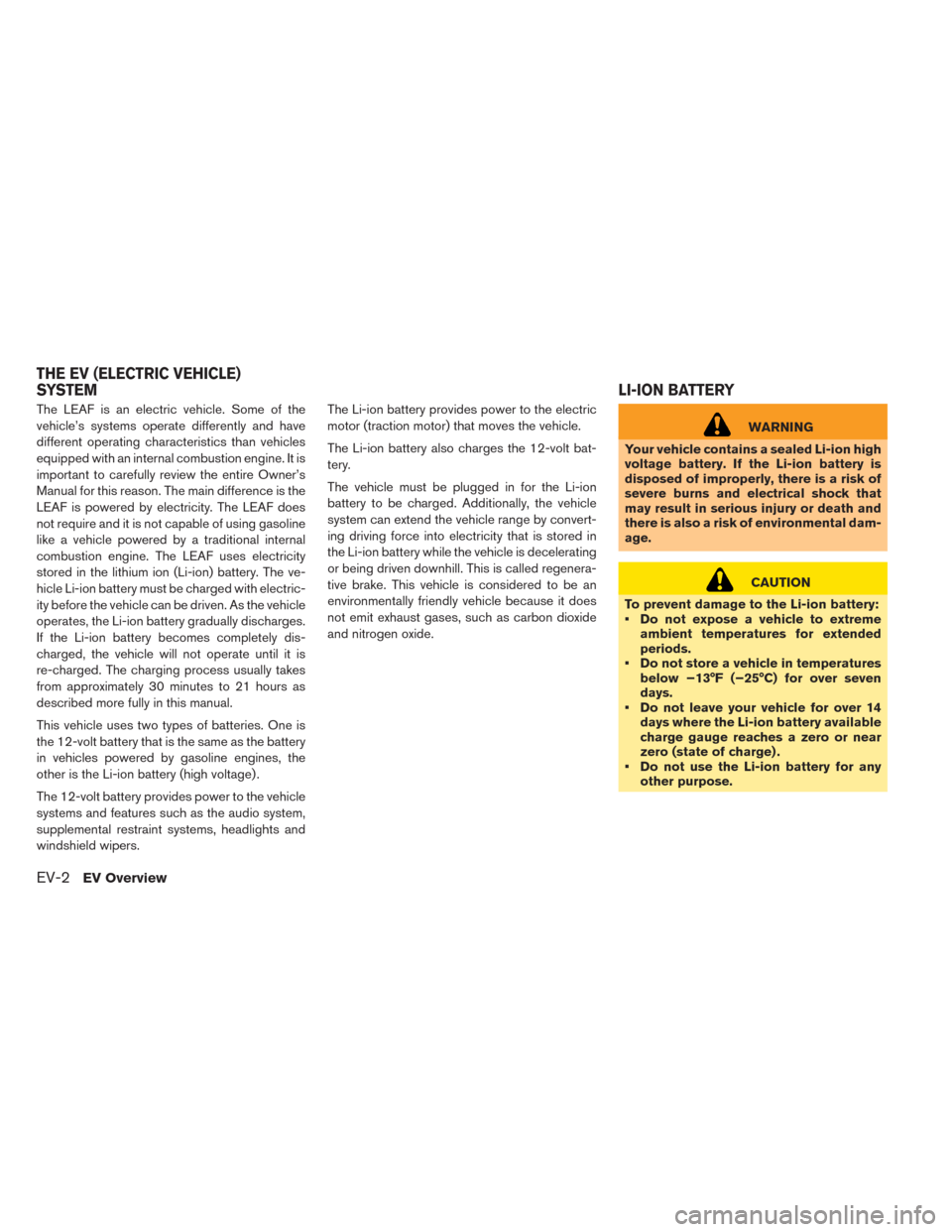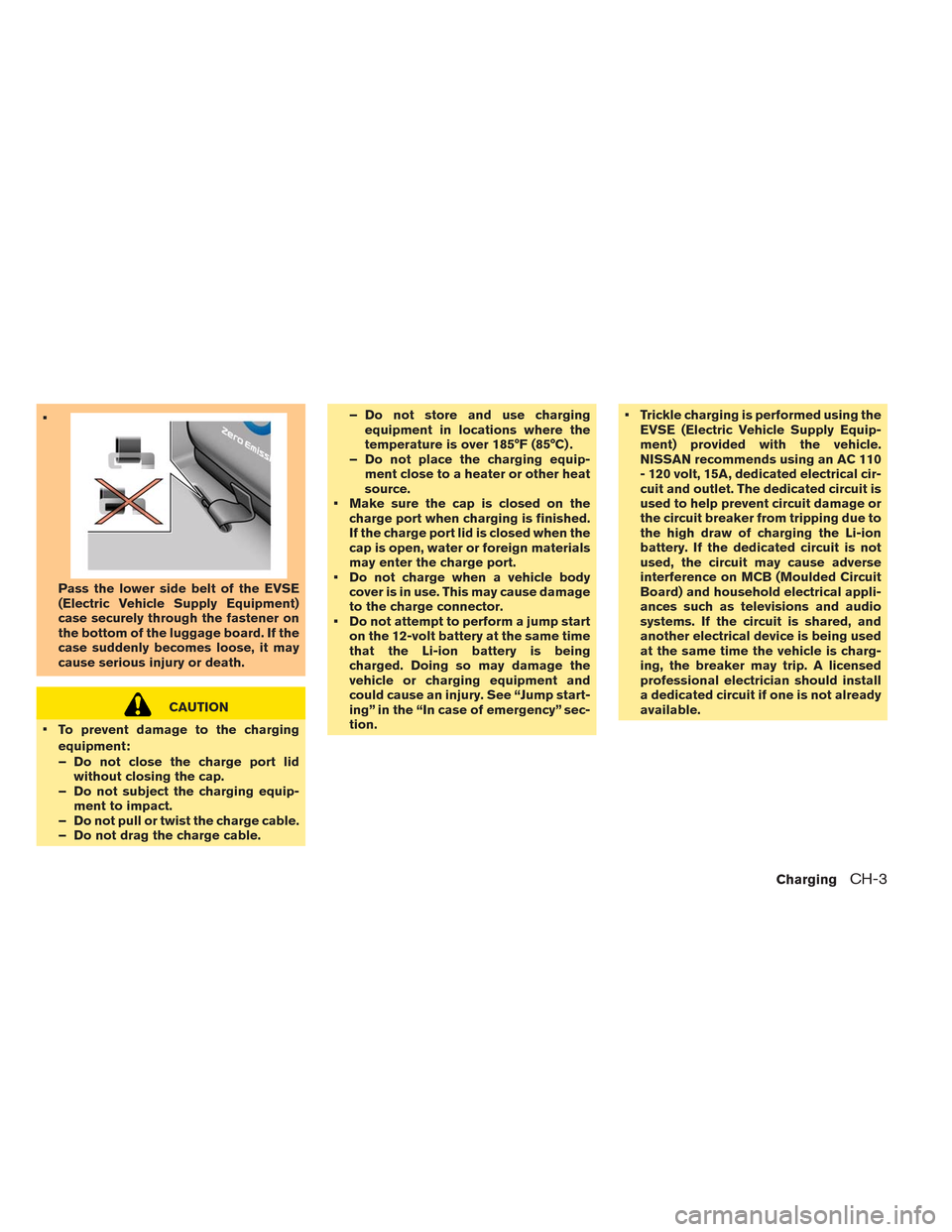Page 2 of 397
Owner’s Manual Supplement
The 2014 – 2015 NISSAN LEAF Owner’s Manual states that this vehicle is
equipped with Bluetooth® streaming audio. This vehicle may not be equipped with
this feature. Sorry for any inconvenience this may have caused.
Printing: March 2014 (11)
Publication No. SU15EA 0ZE0U0
Page 7 of 397
Table of
contentsIllustrated table of contents
EV Overview
Charging
Safety–Seats, seat belts and supplemental restraint system
Instruments and controls
Pre-driving checks and adjustments
Heater, air conditioner, audio and phone systems
Starting and driving
In case of emergency
Appearance and care
Maintenance and do-it yourself
Technical and consumer information
Index
0
EV
CH
1
2
3
4
5
6
7
8
9
10
Page 14 of 397
1. TRIP switch for twin trip odometer (P 2-6)
2. Trip computer switch (P 2-28)3. Instrument brightness control switch
(P 2-42)4. Headlight, fog light (if so equipped) and
turn signal switch
— Headlight (P 2-43)
— Turn signal light (P 2-45)
— Fog light (if so equipped) (P 2-45)
5. Steering-wheel-mounted controls (left side)
(See LEAF Navigation System Owner’s
Manual.)
—
Driving range button (if so
equipped)
— Audio control
— Bluetooth® Hands-Free Phone System
control
6. Steering wheel
— Power steering system (P 5-19)
— Horn (P 2-47)
— Driver’s supplemental air bag (P 1-35)
7. Wiper and washer switch (P 2-39)
8. Steering-wheel-mounted controls (right
side)
— Cruise control switches (P 5-15)
— ECO button (if so equipped) (P 2-47)
9. Fuse box cover (P 8-16)
10. Heated steering wheel (if so
equipped)(P 2-46)
11. Vehicle Dynamic Control (VDC) OFF
switch (P 2-49)
12. Charge timer OFF switch(P 2-50)
COCKPIT
0-6Illustrated table of contents
Page 16 of 397
1. Side vents (P 4-6)
2. Meters and gauges (P 2-5)
3. Center multi-function control panel (See
LEAF Navigation System Owner’s Manual.)
— Navigation system
— Vehicle information and setting buttons— Bluetooth® Hands-Free Phone System
— Audio system
4. Hazard warning flasher switch (P 6-2)
5. Center vents (P 4-6)
6. Rear window defroster switch (P 2-42)
7. Front passenger supplemental air bag
(P 1-35)8. Hood release handle (P 3-16)
9. Power switch (P 5-7)
10. iPod® connector/USB connector (See
LEAF Navigation System Owner’s Manual.)
11. Power outlet (P 2-50)
12. Auxiliary input jack (See LEAF Navigation
System Owner’s Manual.)
13. Front passenger air bag status light/
(P 2-20)/Approaching Vehicle Sound for
Pedestrians (VSP) system warning light
(P 2-15)
14. Heater and air conditioner control (P 4-7)
15. Glove box (P 2-53)
INSTRUMENT PANEL
0-8Illustrated table of contents
Page 22 of 397

The LEAF is an electric vehicle. Some of the
vehicle’s systems operate differently and have
different operating characteristics than vehicles
equipped with an internal combustion engine. It is
important to carefully review the entire Owner’s
Manual for this reason. The main difference is the
LEAF is powered by electricity. The LEAF does
not require and it is not capable of using gasoline
like a vehicle powered by a traditional internal
combustion engine. The LEAF uses electricity
stored in the lithium ion (Li-ion) battery. The ve-
hicle Li-ion battery must be charged with electric-
ity before the vehicle can be driven. As the vehicle
operates, the Li-ion battery gradually discharges.
If the Li-ion battery becomes completely dis-
charged, the vehicle will not operate until it is
re-charged. The charging process usually takes
from approximately 30 minutes to 21 hours as
described more fully in this manual.
This vehicle uses two types of batteries. One is
the 12-volt battery that is the same as the battery
in vehicles powered by gasoline engines, the
other is the Li-ion battery (high voltage) .
The 12-volt battery provides power to the vehicle
systems and features such as the audio system,
supplemental restraint systems, headlights and
windshield wipers.The Li-ion battery provides power to the electric
motor (traction motor) that moves the vehicle.
The Li-ion battery also charges the 12-volt bat-
tery.
The vehicle must be plugged in for the Li-ion
battery to be charged. Additionally, the vehicle
system can extend the vehicle range by convert-
ing driving force into electricity that is stored in
the Li-ion battery while the vehicle is decelerating
or being driven downhill. This is called regenera-
tive brake. This vehicle is considered to be an
environmentally friendly vehicle because it does
not emit exhaust gases, such as carbon dioxide
and nitrogen oxide.
WARNING
Your vehicle contains a sealed Li-ion high
voltage battery. If the Li-ion battery is
disposed of improperly, there is a risk of
severe burns and electrical shock that
may result in serious injury or death and
there is also a risk of environmental dam-
age.
CAUTION
To prevent damage to the Li-ion battery:
• Do not expose a vehicle to extreme
ambient temperatures for extended
periods.
• Do not store a vehicle in temperatures
below −13°F (−25°C) for over seven
days.
• Do not leave your vehicle for over 14
days where the Li-ion battery available
charge gauge reaches a zero or near
zero (state of charge) .
• Do not use the Li-ion battery for any
other purpose.
THE EV (ELECTRIC VEHICLE)
SYSTEMLI-ION BATTERY
EV-2EV Overview
Page 53 of 397

•
Pass the lower side belt of the EVSE
(Electric Vehicle Supply Equipment)
case securely through the fastener on
the bottom of the luggage board. If the
case suddenly becomes loose, it may
cause serious injury or death.
CAUTION
•
To prevent damage to the charging
equipment:
– Do not close the charge port lid
without closing the cap.
– Do not subject the charging equip-
ment to impact.
– Do not pull or twist the charge cable.
– Do not drag the charge cable.– Do not store and use charging
equipment in locations where the
temperature is over 185°F (85°C) .
– Do not place the charging equip-
ment close to a heater or other heat
source.
• Make sure the cap is closed on the
charge port when charging is finished.
If the charge port lid is closed when the
cap is open, water or foreign materials
may enter the charge port.
• Do not charge when a vehicle body
cover is in use. This may cause damage
to the charge connector.
• Do not attempt to perform a jump start
on the 12-volt battery at the same time
that the Li-ion battery is being
charged. Doing so may damage the
vehicle or charging equipment and
could cause an injury. See “Jump start-
ing” in the “In case of emergency” sec-
tion.• Trickle charging is performed using the
EVSE (Electric Vehicle Supply Equip-
ment) provided with the vehicle.
NISSAN recommends using an AC 110
- 120 volt, 15A, dedicated electrical cir-
cuit and outlet. The dedicated circuit is
used to help prevent circuit damage or
the circuit breaker from tripping due to
the high draw of charging the Li-ion
battery. If the dedicated circuit is not
used, the circuit may cause adverse
interference on MCB (Moulded Circuit
Board) and household electrical appli-
ances such as televisions and audio
systems. If the circuit is shared, and
another electrical device is being used
at the same time the vehicle is charg-
ing, the breaker may trip. A licensed
professional electrician should install
a dedicated circuit if one is not already
available.
ChargingCH-3
Page 139 of 397
1. TRIP switch for twin trip odometer
2. Trip computer switch
3. Instrument brightness control switch4. Headlight, fog light (if so equipped) and turn
signal switch
— Headlight
— Turn signal light
— Fog light (if so equipped)5.
Steering-wheel-mounted controls (left side)
(See LEAF Navigation System Owner’s
Manual.)
—Driving range button (if so
equipped)
— Audio control
— Bluetooth® Hands-Free Phone System
control
6. Steering wheel
— Electric power steering system
— Horn
— Driver’s supplemental air bag
7. Wiper and washer switch
8. Steering-wheel-mounted controls (right
side)
— Cruise control switches
— ECO button (if so equipped)
9. Fuse box cover
10. Heated steering wheel (if so equipped)
11. Vehicle Dynamic Control (VDC) OFF
switch
12. Charge timer OFF switch
13. Charge connector lock switch
14. Charge port lid opener switch
15. Tilting steering wheel lever
16. Heated seat switch
17. Shift lever
18. Storage tray
COCKPIT
Instruments and controls2-3
Page 140 of 397
1. Side ventilator
2. Meters and gauges
3. Center multi-function control panel (See
LEAF Navigation System Owner’s Manual.)
— Navigation system
— Vehicle information and setting buttons
— Bluetooth® Hands-Free Phone System— Audio system
4. Hazard warning flasher switch
5. Center ventilator
6. Rear window defroster switch
7. Front passenger supplemental air bag
8. Hood release handle
9. Power switch10. iPod® connector/USB connector (See
LEAF Navigation System Owner’s Manual.)
11. Power outlet
12. Auxiliary input jack (See LEAF Navigation
System Owner’s Manual.)
13. Front passenger air bag status light/
Approaching Vehicle Sound for Pedestri-
ans (VSP) system warning light
14. Heater and air conditioner control
15. Glove box
INSTRUMENT PANEL
2-4Instruments and controls